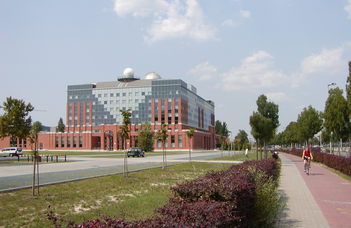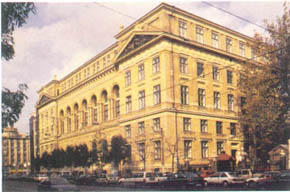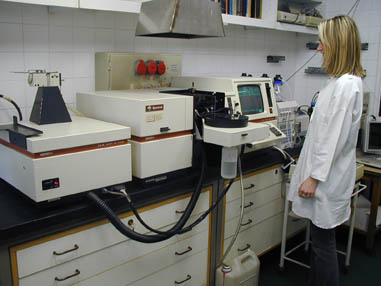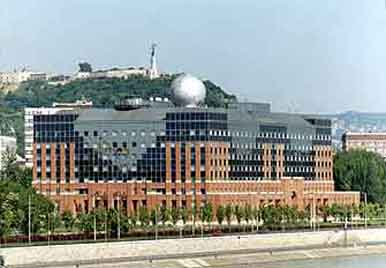The History of the Faculty

The structure of the university remained unaltered for almost 200 years. Until 1949 it consisted of the Faculty of Law, the Faculty of Philosophy and Art, the Faculty of Theology, and the Faculty of Medicine. With the goal of developing natural sciences, the Faculty of Science was established on the 16th of May 1949, merging 22 departments and institutes of the Faculty of Philosophy and Art, the Botanical Garden, the Institute of Physics and Chemistry, and the Institute of Anthropology. In 1953 the Faculty of Science was split in two: the Faculty of Mathematics, Physics, and Chemistry and the Faculty of Life and Earth Sciences. The two faculties were reunited in 1957.
For a hundred years, it has been our tradition to award the most distinguished Hungarian and foreign scientists and most influential public figures the title of honorary doctorate. We are genuinely proud to have granted this award to Professor Bunsen from Heidelberg, Professor Kelvin from Glasgow, French chemist Pierre Berthelot, Nobel Laureate physicist Heisenberg, Russian mathematician Andrej Kolmogorov, Pál Erdős and Károly Than. Some of the most distinguished minds of our Faculty and the most well-known late professors include György Békésy, Gusztáv Buckböck, László Detre, László Egyed, Loránd Eötvös, Lipót Fejér, Miksa Hantken, György Hajós, Miksa Hell, György Hevesy, Lajos Jánossy, Ányos Jedlik, Pál Kitaibel, Radó Kövesligethy, József Krenner, Béla Lengyel, Lajos Lóczy, Árpád Paál, Rudolf Ortvay, Alfréd Rényi, Frigyes Reisz, Rezső Soó, József Szabó, Gábor Zoltán Szabó, Elemér Szádeczky-Kardoss, József Száva-Kováts, Imre Kálmán Sztrókay, Károly Tangl, Aurél Török, Pál Turán, Lajos Winkler.
Several of our current lecturers were awarded the Széchenyi Prize, the Szent-Györgyi Albert Prize, or other similarly honorable prizes. Mathematician László Lovász was awarded the Wolf Prize in 1999 and the Kyoto Prize in 2010, which are considered equivalent to the Nobel Prize (since there is no mathematics Nobel Prize).

Our Faculty has five Institutes encompassing seven scientific fields and one educational organization, all under the direct leadership of the Dean.
The Institute of Biology consists of twelve departments and one methodology group, and it provides the most diverse programs and research opportunities in Hungary. Educational profile: the training of biology and nature and environmental studies teachers, biologists, environmental scientists, pharmaceutical chemists, psychologists, and bioengineers. Main fields of research: anthropology, protein and gene technology, neurophysics, ethology, molecular cell biology, immunology, environmental microbiology, ecology, plant anatomy, and physiology and zoology.
The Institute of Physics consists of five departments. Educational profile: the training of physicists and physics teachers and providing an opportunity for other students of the Faculty to learn the fundamentals of physics. The main fields of research encompass almost every branch of physics: from the research of quarks and other elementary particles to the investigation of the nano-structure of graphene and the physical operation of proteins, the study of black holes, gravitational waves, and the largescale structure of the universe. Besides the traditional fields of physics, there are several internationally successful pieces of research concerning new areas, such as chaos theory or complex networks.
Inside the Institute of Geography and Earth Sciences, there are two separate centers:
The Center of Geography consists of four departments and an associate unit. Educational profile: the comprehensive training of geographers and geography teachers. Main fields of research: the landscape geography and mapping of Hungary and the evaluation of society's effects on the environment based on field research and laboratory analysis. Other fields include the study of regional development tendencies in Europe and Hungary and the geography of world economics.
The Center of Earth Sciences has seven departments, one division, and three associated units. Educational profile: the training of bachelor students of Earth sciences, providing them with an opportunity to specialize in one of the disciplines belonging to the Centre. Providing additional courses for bachelor students of environmental studies and physics. Training astronomers, geologists, geophysicists, and meteorologists, providing introductory courses for students enrolled in physics or the teacher training program.
Main fields of research: utilizable metallic and non-metallic raw materials, the study of hydrocarbons, hydrology research, environmental geology, and geomathematics. The structure and development of Earth's crust, formation of mineral raw materials and their exploration and utilization, evaluation of the short and long term changes of the environment, the study of special industrial structural materials (e.g., ceramics), the study of the geological history of Hungary, the exploration of the development of life using the modern methods of paleontology and paleobiology. Physics of the Sun, the structure and dynamics of the Galaxy, the investigation of the early phase of the development of stars, high dispersion spectroscopy, physics of interstellar material, cosmogony, emitting and flare stars, spherical mechanics, the global study of Earth, plate tectonics and basin development, environmental geophysics and geophysics of raw materials, space research and remote sensing, dynamic atmosphere models, climatology, research of agro- and micrometeorology.
 The Institute of Chemistry consists of four departments and sixteen laboratories. Educational profile: the training of chemists and chemistry teachers. The Institute also plays an active role in the training of pharmaceutical chemists of Semmelweis Univesity and other students of our Faculty. Main research fields: NMR spectroscopy of organic and inorganic compounds, environmental analytical chemistry, corrosion, nonlinear reactions, Mössbauer spectroscopy, X-ray spectroscopy, positron annihilation spectroscopy, electrochemistry, colloid chemistry, quantum chemistry, organometallic chemistry, peptide chemistry, and solid-state chemistry.
The Institute of Chemistry consists of four departments and sixteen laboratories. Educational profile: the training of chemists and chemistry teachers. The Institute also plays an active role in the training of pharmaceutical chemists of Semmelweis Univesity and other students of our Faculty. Main research fields: NMR spectroscopy of organic and inorganic compounds, environmental analytical chemistry, corrosion, nonlinear reactions, Mössbauer spectroscopy, X-ray spectroscopy, positron annihilation spectroscopy, electrochemistry, colloid chemistry, quantum chemistry, organometallic chemistry, peptide chemistry, and solid-state chemistry.
The Institute of Mathematics consists of seven departments and one associated unit. Educational profile: the training of mathematics teachers, mathematicians, and applied mathematicians, as well as providing the basic introductory mathematics courses to other students of the Faculty. Special mathematics courses. Main fields of research: algebra and number theory, analysis, applied numerical analysis, computational mathematics, geometry, topology, information theory, probability theory, mathematical statistics, operations research, discrete mathematics, computer science, didactics of mathematics. In the 2016/2017. semester a didactics of mathematics doctoral program was launched by the Ph.D. School of Mathematics.
The Center of Environmental Sciences operates under the Dean's direct leadership.
The Institutes place great emphasis on involving students and Ph.D. students with the professors' research fields through Scientific Students' Association projects and degree thesis topics. They also provide them with unique opportunities, such as getting introduced to the most modern computer simulation and data analysis methods in the Institute of Physics. Most of the research is international; therefore, students involved with them get the chance to join the top international programs or industrial cooperation.
Our Faculty has been located on the side of the Danube in Lágymányos, Budapest, between Petőfi Bridge and Lágymányos Bridge since 2001.

Our different Institutes excel in different ways. Most inventions and patents were born in the scientific workshops of the Institute of Chemistry. Most international publications are written by the professors and researchers of theInstitute of Physics and the Institute of Mathematics. The Center of Geography has organized significant expeditions and actively participated in creating the new regional development system. In the Center of Earth Sciences, which is looking for new horizons due to the cutback in mining in Hungary, significant researches of industrial structural materials are being conducted. Furthermore, the study of the moon rocks lent by NASA and the meteorite collection from Antarctica lent by Japan lead to a significant breakthrough in space research. The Center is part of a broad international cooperation that has organized many successful projects to learn more about Earth, its surface, atmosphere, and outer space. The Departments of the Institute of Biology are leading in molecular biology research and application, research and protection of biodiversity, and environmental protection both in Hungary and Europe.
The Bolyai College offers unique scientific education opportunities for the brightest students of the Faculty.
Besides teaching the traditional disciplines of natural sciences, the Faculty wishes to open up for activities that can integrate the work of the Departments into different promising initiatives. The best known of these are the environmental programs - e.g., the Institute of Biology's Center of Environmental Studies - and space research, which celebrated its 50th birthday in 1996. The aspiration following the baffling speed of development of informatics is also decisive at the Faculty. Among domestic industrial or academic researches, every Institute of the Faculty is recognized to represent the highest standard of its given field. In 2016 there were 21 MTA (Hungarian Academy of Sciences) research groups at the Faculty.
Besides the bachelor programs, there are multiple graduate and postgraduate programs at our Faculty. All of our natural science topics received accreditation, and applicants can choose from 27 doctoral programs of 6 Ph.D. schools. We also offer graduate programs in Microbiology and Hydrology. Our Faculty's two most visited courses are "From the atoms to the stars - Chapters from the latest results of physics" and "Up to date content and methods for the XXI. century education of physics".
The Institute of Physics' lecture series titled "From the atoms to the stars" has been running since 2005, with 14-15 ninety minutes long lectures followed by experiments every year. Although the primary audience is high school students, many adults attend as well, and the series had even been accredited as pedagogue training for physics teachers. The lectures are held by researchers of the Institute of Physics and other ELTE graduates working at other domestic or foreign institutes. The topics are their own fields of research or the latest developments in physics. This program played a significant role in the rise in bright and promising students applying for the physics program of ELTE.
The "Alchemy Today" organized by the Institute of Chemistry and the "Live Transmission" organized by the Institute of Biology are two other lecture series that are also popular with high school students
The Museum of Natural History was opened in June 2002 and is located in the Southern Building of the Lágymányosi Campus. It was officially established in 2004, and it consists of a Mineralogical Collection, a Biological Collection, a Paleontological Collection, and a Mathematical Collection.
The Faculty Library was established in January 2002. It has a collection of biology, physics, Earth sciences, geography, chemistry, environmental physics, mathematics, and collections of Mediabase (where a reading machine helps the visually impaired) and the EISZ cabinet.
Hungary's first digital planetarium was opened in our Faculty. It can be visited by groups (from kindergarten age) after booking.
The Faculty has a life coach to whom students and employees can turn with their problems.

